Returning to us to continue our learning? Please feel free to jump ahead to where you left off by clicking the following personality types:
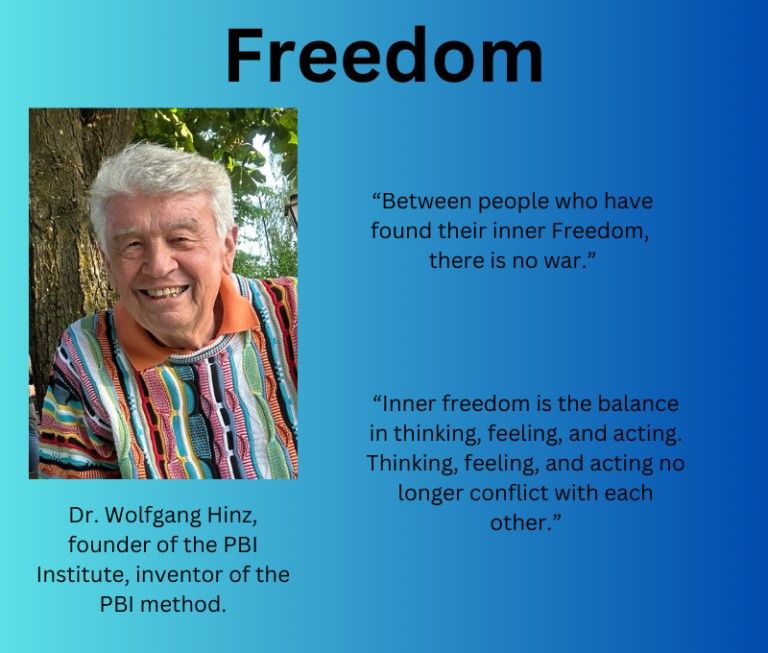
Mental strength, as a key concept in psychology, is the ability to remain calm in the face of problems, worries, stress, and fear. It means implementing the ideas you have set for yourself, achieving goals, fully realizing your potential, and dealing constructively with criticism. There are several approaches to developing mental strength. The most well-known approach is resilience, while the most effective one is balance—the equilibrium between thinking, feeling, and acting.
‘Hans Helper’ is proud of his willingness to help. If someone asks him for help, he simply provides it. Often, he even actively offers assistance when he sees that he is needed. He has a strong ability to empathize with others and feels deep compassion when people around him suffer. Hans knows that his behavior is highly valued by society.
“How beautiful the world would be if everyone behaved as exemplarily as I do,” Hans thinks.
He has never said “no” in his entire life. He simply cannot do it. Hearing “You have to help me now” always triggers his helper reflex. Because of this, he is often taken advantage of. However, there are situations in Hans life where saying “no” would be the better response.
Let’s take a look at a comment from Heike Helper on this topic:
“I have learned to say ‘no’ and to recognize my own limits. It was hard work, but it was worth it. As someone who has experienced burnout, I know very well how important it was for me to take this step and to have the freedom to decide where I set my boundaries. The best part is: I have more energy and joy in life, and I often say ‘yes’—but now, I do it with all my heart.”
This story of Hans and Heike’s comments show two people with the same personality type (Helper) at different stages of development. Hans cannot say “no”, while Heike has painfully learned to do so.
This clearly illustrates that there are different developmental stages in human behavior
Hans demonstrates unbalanced behavior, while Heike’s behavior can be described as balanced. Heike is able to say both “yes” and “no” in appropriate situations, giving her a greater range of behavior than Hans, who has never learned to say “no”. The disturbed developmental stage is of particular interest to experts, so we leave that area to them. Within PBI (personality, balance, identity) our focus is on the unbalanced and balanced stages, as well as the distinction between the two.
Max is a fitness trainer. This afternoon, he has to entertain his two-year-old daughter, Maja. After lunch, he suggests going for a short ride. “No, that’s boring,” says Maja. Playing with a ball, however, is well received. Afterward, Max suggests jumping on the trampoline. “No, I don’t want to,” says Maja. That afternoon, “no” appeared in every other sentence she said. Saying no is child’s play for Maja.
This illustrates an important insight: the ability to say “no” is something we are born with. Over time, some people—especially Helper types—learn to suppress it in favor of being liked or needed. Relearning this simple but powerful word is a key step toward balance.
No one has to change: everyone retains who they are. Everyone can learn: supplementing the basic pattern with complementary behavior is particularly rewarding.
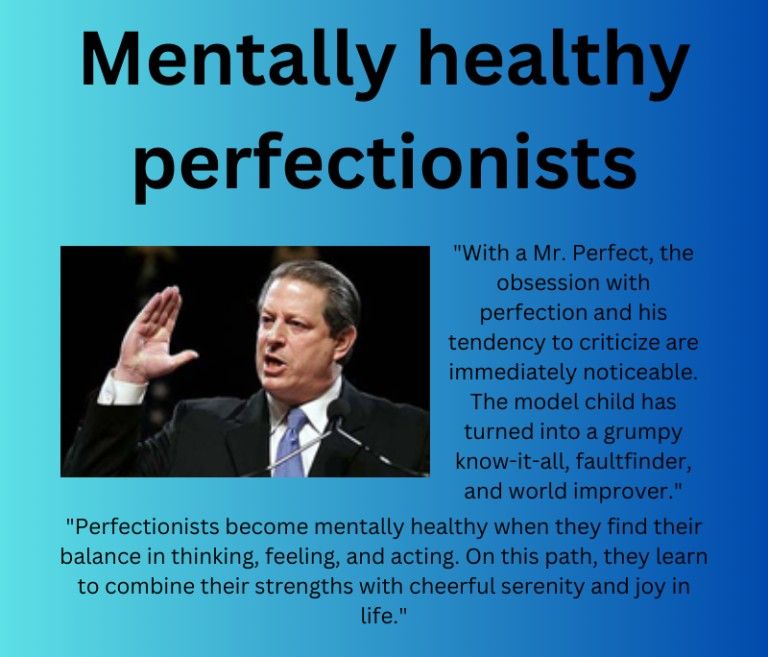
Principle-driven perfectionists feel an inner compulsion to turn disorder into order. They struggle with complexity and often fall into roles such as know-it-alls, self-righteous individuals, world improvers, moralizers, pedants, sticklers for principles, complainers, puritans, order fanatics, cleaning obsessives, and critics. Perfectionists achieve mental well-being when they learn to combine their strengths with cheerful composure and joy in life. On this path, they learn to accept life as it is. They become more realistic and balanced, treating others with greater patience and understanding. The more they let go of their obsession with perfection, the more they experience true perfection—not as flawlessness, but as a state of wholeness and balance within the beautifully complex order of life.
Development Opportunities in the Areas of Feeling and/or Acting:
Peter’s judging and critical mind is highly developed. Anything that appears flawed or inadequate immediately catches his attention. He almost always seems frustrated because people and life itself do not align with how he believes they should be. He is organized and diligent, but also highly critical, with exacting standards. He always finds the flaw in the plan.
His recommended integration path points toward “developing more joy in life.” Through this development, he combines his strengths with composure and joy. He becomes more realistic and balanced, letting go of his mission to improve the world. He becomes more forgiving toward others, and his rigidity softens to a more humane level. His sense of social responsibility is expressed through integrity and reliability. His judgments are regarded as just, balanced, and fair. He comes to understand: Perfection is already present. He learns to embrace his emotions. At the developed stage, the perfectionist becomes more realistic and balanced. He is more tolerant of others and accepts that there are many paths to the same goal, not just the one he initially believed in. His integrity and reliability, his willingness to take responsibility, and his ability to stand by his values even in difficult situations come into full effect. He has become a patient listener. His judgments are seen as just, balanced, and fair.
The wise realist no longer suppresses his emotions. He becomes more realistic and tolerant, including towards himself. He possesses clear judgment and lives in the real world, not in an idealized, imaginary world of perfection. He has learned to be generous with himself and others.
The rational-minded person is insightful and cautious, thinks clearly and logically.
He possesses exceptionally good judgment and does not shy away from taking responsibility for his decisions and actions. He strives to minimize mistakes but is willing to admit errors when he recognizes them.
The principle-driven teacher leads a moral and meaningful life, guided by his conscience. He abhors injustice in all forms, whether it affects his friends, strangers, or himself. He is honest, principled, and deeply ethical. For him, it is unthinkable to lie to or deceive anyone.
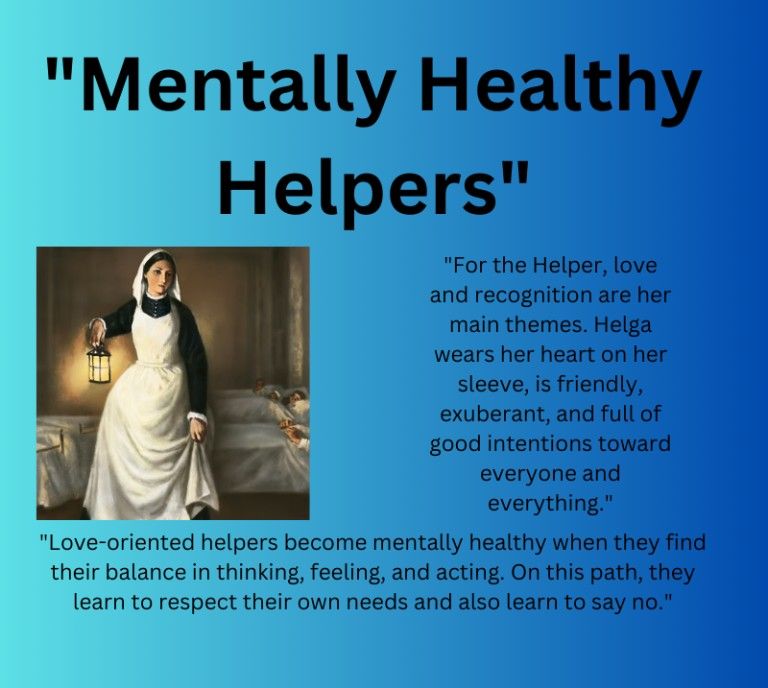
Love-oriented helpers take pride in their dedication to others, their willingness to help, and their caregiving nature. They need to be needed. Thanks to their sociability, they find it easy to form acquaintances and friendships. Their helpfulness, kindness, and favors are highly valued and socially accepted. However, they also have a shadow side—one that helpers tend to ignore and suppress: They are not entirely selfless. In return for their help, they expect gratitude. It is a transaction:
“My willingness to help in exchange for your love and recognition.” This makes them vulnerable to exploitation. Helpers achieve psychological well-being when they overcome their compulsive need for love and recognition. Mentally healthy helpers are selfless, altruistic, and generous, yet they do not lose their own identity in the process. They remain loving, compassionate, and attentive to the needs of others, without sacrificing their own well-being.
Development Opportunities in Thinking and/or Acting
The emotional state of the Helper depends on the sympathy or rejection they receive from others. They constantly adapt to those around them, trying to meet their needs. This weakens their own identity and self-esteem. Their sense of self becomes so entwined with the desires and needs of others that their identity seems to exist outside of themselves. As a result, they often experience emotional chaos. They create many problems for themselves because they struggle to say “no.”
Helpers often promise more than they can fulfill, and when they fail to deliver, they feel guilty. They have development opportunities in the areas of THINKING and/or ACTING.
The recommended integration path leads toward “developing greater self-worth.” On this path, the Helper learns to respect their own needs and to say “no.” They become more in touch with their own desires and authentic emotions, ultimately rediscovering their true identity. With this, they can express warmth as genuine compassion, without expecting anything in return. They develop a keen sense of the unique needs and growth potential of others. This ability allows them to help others recognize their own potential and encourage personal development. The developed Helper becomes humble and respects the dignity and privacy of others. They offer protection to those in need—not out of obligation, but as a genuine, authentic, and self-assured personality, free from the compulsion to be liked. This protects others from the discomfort of feeling indebted by gratitude.
The Altruist is selfless, altruistic, and capable of showing affection to others without expecting anything in return. He firmly believes that good must be done, regardless of who does it or who receives the gratitude. His selflessness allows him to clearly recognize the needs of others without his own interests getting in the way.
The Empathetic One is deeply concerned with the well-being of others. Emotionally attuned to people, he is the most empathetic of all personality types. As a result, he develops compassion and care. He is full of kindness, sincerity, and warmth.
The Caregiver wants to express his love for humanity. Helpfulness is a key value for him. He serves those who are in need and unable to care for themselves. He feeds the hungry, clothes the naked, and visits the sick. However, he does not allow himself to be taken advantage of.
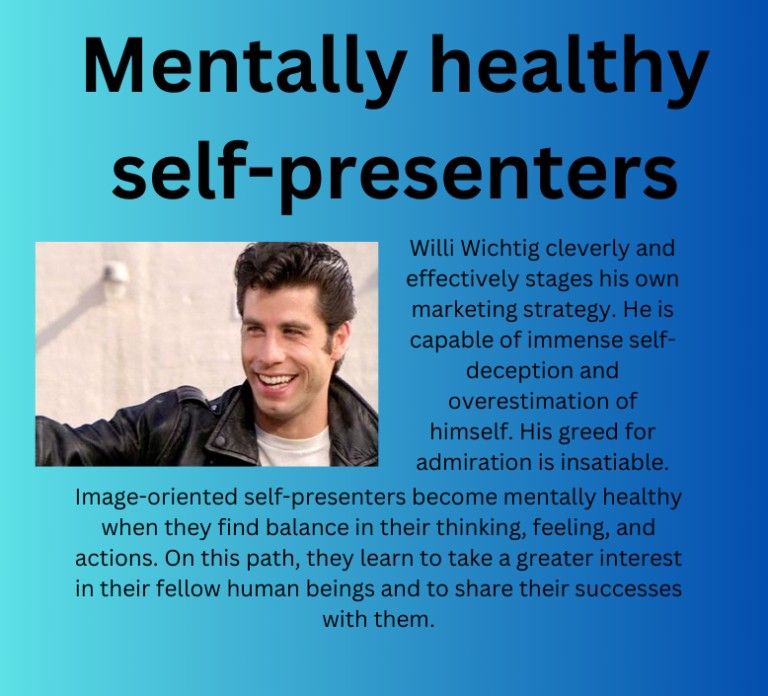
Image-oriented self-promoters are constantly under time pressure and often appear rushed and driven. Their central concepts are work, achievement, competition, success, image, competence, outfit, design, packaging, enthusiasm, and projects. They skillfully and effectively stage their own marketing strategy. Self-promoters are addicted—their drug is admiration.
Becoming mentally healthy is like rehab for self-promoters. They must overcome their compulsive addiction to admiration. On this path, they master their fear of failure and learn to share success with others. As a result, people offer them genuine love and appreciation instead of mere admiration.
Psychologically healthy self-promoters are adaptable, energetic, often attractive, charming, and well-liked. They are highly communicative and extroverted and have a remarkable ability to inspire enthusiasm in others.
Development Opportunities in Thinking and Feeling:
Self-promoters are ambitious, cheerful, positive-thinking, and full of optimism. They are often good-looking, successful individuals who seem to have everything flowing for them. In reality, they work hard for their success and ensure that their projects are a success. However, it serves their image when everything looks easy and casual, and their efforts are not evident. The self-promoter is constantly under time pressure, is always driven, and often appears rushed. Work, vitality, performance, competition, rivalry, efficiency, effectiveness, image, success, competence, outfit, optimism, design, packaging, enthusiasm, and projects are their central concepts. They find it easy to make decisions; they cleverly and effectively stage their own marketing strategy. They have development opportunities in the areas of THINKING and/or FEELING.
The recommended integration path points toward “self-criticism and authenticity.” Healthy self-criticism serves as a counterbalance to their overestimation of themselves, bringing them back to reality and making them more balanced and realistic. The developed self-promoter becomes more interested in others and learns to share success with them. This path of integration feels like a withdrawal from the “drug” of admiration. Now, they no longer need to play a role. They can drop the mask, let go of self-deception, and gain access to their true emotions, leading to greater emotional depth. The developed self-promoter has overcome their compulsive need for admiration. They have mastered their fear of failure and are now capable of sharing their successes with others, who, in return, offer them genuine love and appreciation instead of mere admiration. They have reconnected with their emotions and let go of self-deception. They are at peace with themselves, sincere, and credible. This makes them self-confident and filled with self-respect. The developed self-promoter is adaptable, energetic, often attractive, charming, and well-liked. They frequently excel in some area of life and serve as an inspiration to others. They are highly communicative and extroverted, with a remarkable ability to inspire enthusiasm in those around them.
The authentic personality has overcome their addiction to admiration and accepts themselves as they are. As a result, their true emotions and identity grow stronger. They recognize their limitations but neither let them hold them back nor try to deny them. They become humble, clear, and direct.
Their self-confidence and sense of being desired make them highly attractive, encouraging new interactions. This, in turn, creates a continuous cycle of self-validation and reinforcement.
Since they are at peace with themselves, they naturally engage in actions that enhance their self-respect even further. They invest time and energy into their personal growth and education. They are ambitious and strive to become the best version of themselves. They serve as a role model in line with the values of their society, setting an example of excellence that others look up to.
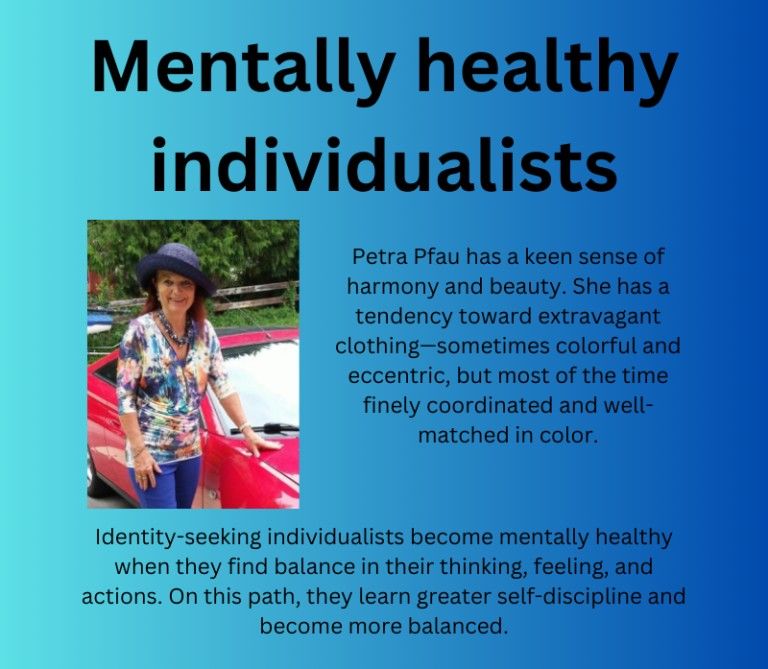
Externally, identity-seeking individualists can often be recognized by their preference for striking clothing—sometimes colorful and bold, but often tastefully coordinated and aesthetically refined. They have a strong sense of harmony and beauty. Their emotional spectrum frequently reaches extremes: “Ecstatic joy one moment, deep despair the next.” They reject anything that is conventional, ordinary, ugly, dirty, or mediocre. Individualists achieve psychological well-being when they learn to complement their creativity with appropriate discipline. Through this process, they overcome self-absorption and introspection and begin to engage with the practical aspects of real life. By finding their balance, they hide nothing, remain honest, genuine, and compassionate, while still maintaining emotional stability.
Development Opportunities in Feeling and/or Acting
Individualists avoid ordinariness. They reject anything conventional, normal, ugly, dirty, or mediocre. The mere thought of being like everyone else fills them with panic and fear. Individualists must stand out—they feel an irresistible need to be unique and different. Their distinctive behavior gives them status, a social circle, a place in life, and the admiration of others. Some individualists shape their entire lives as a work of art: Their clothing, home décor, friendships, hobbies, relationships, and habits are all meticulously curated, Yet, they make it seem effortless and spontaneous. They develop a sharp sense of authenticity, easily distinguishing between the original and the fake. They have development opportunities in the areas of FEELING and/or ACTING.
Through personal growth along the integration path, an individualist overcomes inhibition and introversion. They no longer allow themselves to be ruled by mood swings and emotions. Instead of falling into self-pity, they learn self-discipline and become more balanced. They now face life’s challenges with decisive action: They address injustices instead of just complaining about them. They confront life’s situations instead of withdrawing into their shell. By engaging with reality and the needs of others, they lose their overwhelming need to feel special. They no longer retreat into fantasy worlds—instead, they become more present in the real world. Through this, they discover their true identity and place in life. Their creativity becomes more accessible to others, and they share their emotional depth with the world.
The developed individualist has overcome self-absorption and isolation, embracing the practical realities of life. They have brought their extreme emotional fluctuations into balance, achieving greater stability. This balance represents a deep, rich, yet harmonious emotionality. Now, they engage sensitively with the present and real life, not just with their fantasies and dreams. They no longer feel the compulsion to see themselves as extraordinary. Instead, they develop an emotional depth that other personality types cannot easily access. Sometimes, they express this depth in timeless, masterful works of art. The developed individualist represents synthesis, connection, and harmony. In their interactions, they are sensitive and intuitive, tactful, discreet, and respectful. They are a strong personality who has found their inner center. They hide nothing they are honest, authentic, compassionate, yet emotionally stable.
The creative person is in touch with the impulses that arise from their unconscious mind. They have learned to listen to their inner voice, while remaining open to external influences. They transform all their experiences even the painful ones into a work of art. They are like a vessel that absorbs everything beautiful, true, and good and shares it with the world.
Inspired creativity can only be expressed through action, by overcoming self-absorption. They are highly sensitive, both to themselves and to others, and they react intuitively. Their intuition allows them to understand how others feel and think, giving them deep insight into the world and human nature.
The expressive person brings their emotions to life. They are the most personal of all types, revealing themselves to others openly and sincerely. They no longer wear a mask to hide their doubts and weaknesses. Instead, they willingly display their vulnerabilities and irrationalities, believing that these are not flaws, but an authentic reflection of their true nature.
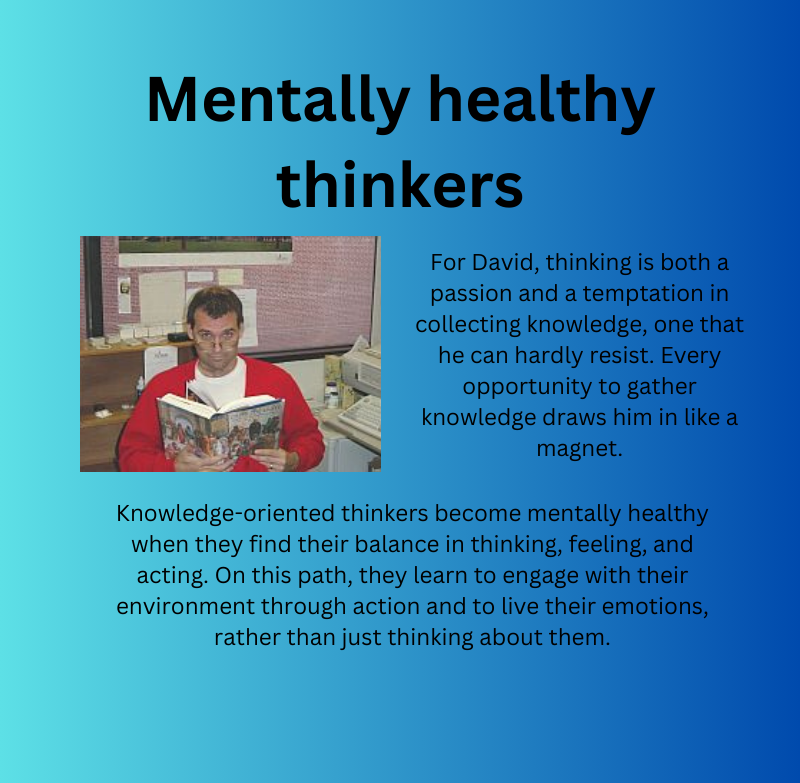
Knowledge-oriented thinkers only think emotions rather than experience them. They don’t want to reveal themselves or display their inner selves. They hate intrusiveness and intruders. One gets the impression that they don’t process external impulses immediately, but rather with a time delay. Between the impulse and the reaction to it, there is always a thought process that serves analysis, classification, and coping with complexity.
Thinkers become mentally healthy when they learn to engage in active action and lived experience. They learn how to gain practical experience through action and that it is by no means necessary to have a detailed knowledge of the goal or solution at the beginning of a chain of actions. This requires them to have the courage to leave safe territory, but at the same time strengthens their self-confidence. They can also learn to live their feelings instead of just thinking them. In this way, they engage with their environment through action and emotionally with those around them.
Development opportunities in feeling and/or acting
The thinker only thinks feelings instead of feeling them. They don’t want to reveal themselves or display their inner selves. They hate intrusiveness and intruders. One gets the impression that they don’t process external impulses immediately, but rather with a time delay. Between the impulse and the reaction to it there is always a thought process that serves the purpose of analysis and classification. This distance from action and feeling is both a strength and a weakness. On the one hand, this distance enables objectification and serenity, but on the other hand it harbors the danger of losing touch with reality. The thinker can restrict themselves and scale back their needs. They can tighten their belts and get by with little in order to remain independent. The thinker has opportunities for development in the areas of feeling and/or acting.
The recommended line of integration points toward active engagement. The Thinker moves beyond the familiar realm of thought and opens up to active doing and lived experience. He realizes that he does not know everything, cannot know everything, and yet knows more than those around him. He learns that, at the beginning of a course of action, it is by no means necessary to already know the goal and solution in detail. This requires the courage to leave safe ground, but at the same time strengthens his self-confidence. He can also learn to reconnect with his emotions and to live his feelings, rather than merely thinking about them. The Thinker transcends the realm of thought and engages with the world through action and with others on an emotional level.
The developed Thinker is a sharp observer, and sometimes even a genius. He is mentally agile, curious, and driven by a spirit of exploration. With his inventive mind, he comes up with original ideas that he is also capable of putting into practice. He is perfectly suited for innovation and pioneering work. We encounter him in three expressions: the pioneer and visionary, the perceptive observer, and the knowledgeable expert.
The Pioneer and Visionary possesses a seemingly paradoxical ability, they can both analyze reality in-depth while simultaneously seeing the broader picture. They recognize patterns and structures where others see only chaos.
They have a gift for foresight, as they understand the world with extraordinary clarity. Like a weaver, they see the intricate design of a tapestry in their mind before it is even complete.
The Perceptive Observer is the most intellectually awake personality, approaching everything with curiosity. They love thinking for the sake of thinking. “I think, therefore I am.” For them, acquiring knowledge is a joyful experience. They relish learning and discovery. Nothing escapes their attention, because they do not just passively observe the world—they actively analyze how structures form and what meaning they hold.
The Knowledgeable Expert accumulates knowledge through observation, insight, and understanding. They love to apply their knowledge in practical ways to see how it aligns with reality and how they can influence the world through it. They possess expertise across multiple fields and are a true specialist. They enjoy sharing knowledge and are often regarded as a trusted authority in their areas of expertise.
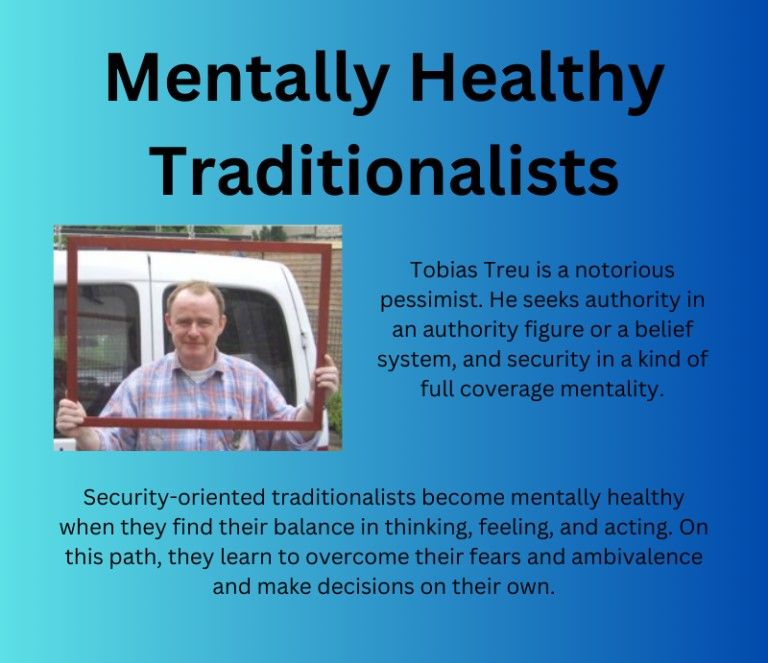
Security-oriented traditionalists are both cautious, hesitant, and skeptical, yet at the same time, they are reliable, dedicated, and responsible within the communities to which they feel committed. Faith in authority and security are key aspects of their personality. “Yes” and “but” are their most frequently used words. Traditionalists achieve psychological well-being when they overcome their fears and dependence on authority. Stronger self-confidence leads to a more positive outlook, which is expressed through courage and creativity. Mentally healthy traditionalists are charming, lovable, friendly, and cheerful. Mutual trust and forming long-term relationships are very important to them. They are cooperative, reliable, trustworthy, and willing to contribute.
Development Opportunities in Thinking and/or Acting
Traditionalists express themselves within the tension between the poles of fearfulness and recklessness. Both are dominant aspects of the traditionalist personality spectrum. The fearful traditionalist is cautious, hesitant, and distrustful. The reckless traditionalist, on the other hand, prefers to charge ahead rather than torment himself with deep-seated fears. He overcompensates for his fear through a display of toughness, demonstrations of strength, and reckless behavior.
Belief in authority and a focus on security are key aspects of the traditionalist personality. They seek authority in a person of power or within a belief system, and security in a kind of “full-coverage” mentality.
Traditionalists have opportunities for growth in thinking and/or action.
On the line of integration, the traditionalist overcomes their fears and their ambivalence. This is a process of learning and development that overcomes their limitations without losing their strengths. The fine antenna for threats and dangers of all kinds remain with them. As does the ability to recognize contradictions, weak points, and inconsistencies in the arguments and standpoints of others with crystal clarity.
The developed traditionalists have overcome their fears and also their dependence on an authority. They have become self-confident and independent. The strengthened self-confidence leads to a positive basic attitude and is expressed in courage and diverse creativity. Developed traditionalists are attractive, lovable, friendly, and exuberant. Mutual trust and entering into lasting relationships are important to them. They behave very responsibly toward the community with which they identify, and they are cooperative, reliable, trustworthy, and ready to contribute.
The self-confident personality has learned to assert themselves confidently. They possess self-assurance, are accepted, and feel comfortable in their own skin. Their self-confidence stems from knowing their own worth without having to rely on authority. They are thoroughly cooperative, an equal partner who can interact with others without fear.
The lovable person believes that human connection is essential and that their well-being depends on building and maintaining positive relationships. Their core value is trust, they seek someone who provides them with security and acceptance. To achieve this, they develop a natural ability to attract and emotionally connect with others.
The loyal friend has a deep need to form lasting bonds with others.
However, this need is often tinged with underlying fear. To ensure stable and enduring relationships, they invest heavily in their connections, showing exceptional loyalty and reliability. Their faithfulness is lifelong, as it is not based on a superficial choice, but on a deep identification with those they care about. This commitment becomes an integral part of their personality.
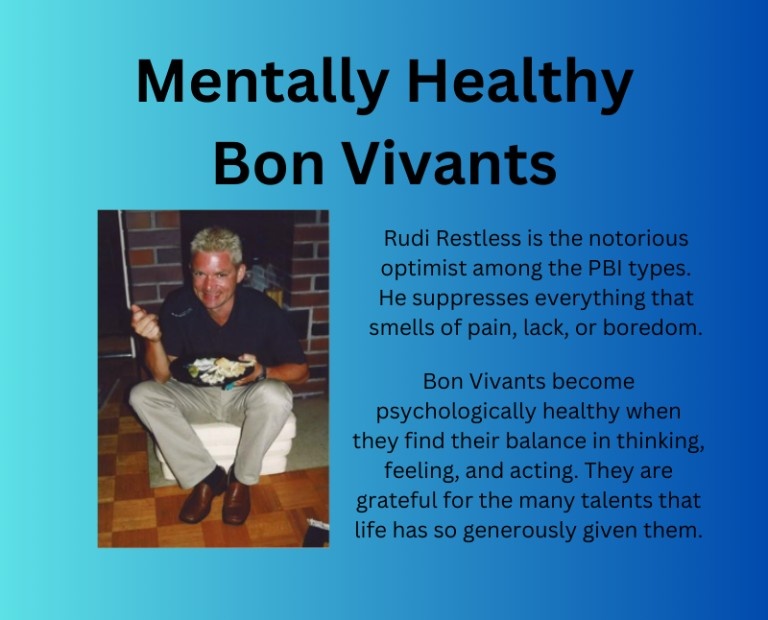
The recommended integration path leads toward “deeply felt joy for life.” This does not take away from the Bon Vivant’s optimistic, life-affirming energy. Instead, they experience a sense of reverent gratitude for their many talents, which they begin to see as a gift. They start to embrace profound experiences and become more attuned to the emotions of others. Their communication style shifts from superficial chatter to one of greater depth. They slow down their pace and learn to see life in its full complexity and accept it— The beautiful and the ugly, the pleasurable and the painful. They no longer suppress uncomfortable realities, and in doing so, they become whole and complete.
Joyful Bon Vivants are the eternal optimists among the PBI types. Here we find multi-talents, jack-of-all-trades, trendsetters, enthusiasts, epicureans, hyperactive individuals, and naturally cheerful people. However, they also have a shadow side—they suppress and ignore anything that resembles pain, deprivation, or boredom. Bon Vivants achieve psychological well-being when they face these aspects of life and learn to deal with them constructively. They retain their optimism but gain a deeper, more authentic joy for life. Mentally healthy Bon Vivants are grateful for the many talents and opportunities life has given them. They become more attuned to the emotions and well-being of others. Their communication style shifts from chatter and superficial talk to one of depth and meaning. They begin to embrace life in its full spectrum—both beauty and ugliness, joy and pain.
Development Opportunities in Thinking and/or Feeling
The Bon Vivant flees from boredom. They seek amusement and crave as many different experiences as possible.
Material possessions are important to them, as they enable new pleasures and entertainment. They constantly dive into new activities, always chasing distractions and seeking new stimuli to stay engaged. They are always on the move, avoiding stillness at all costs.
The developed Bon Vivant remains cheerful and full of life, spreading good energy, but now they process experiences on a deeper level. They approach life’s wonders with fascination, respect, and gratitude. Blessed with many talents, they are happy, energetic, enthusiastic, and spontaneous. The developed Bon Vivant appears in three forms:
The Ecstatic Enjoyer is realistic enough to accept life as it is. They discover that everything life offers is enough to bring them satisfaction and contentment. Through a profound connection with reality, they experience intense happiness and learn to love life as it is.
The Happy Enthusiast is more open to experiences than any other personality type. They are stimulated by the sensory world and wish for their enthusiasm to last as long as possible. They live primarily in the external world, surrounded by a network of activities and interests.
The Skilled All-Rounder is exceptionally practical and productive. Almost everything they attempt is successful. They are multitalented, and it is astonishing how many things bring them joy.
They excel effortlessly in many areas: They speak multiple languages, They play several musical instrument, They excel in their profession, They cook well, ski, and are knowledgeable about art, music, theater, and much more, They handle everything in life enviably well.
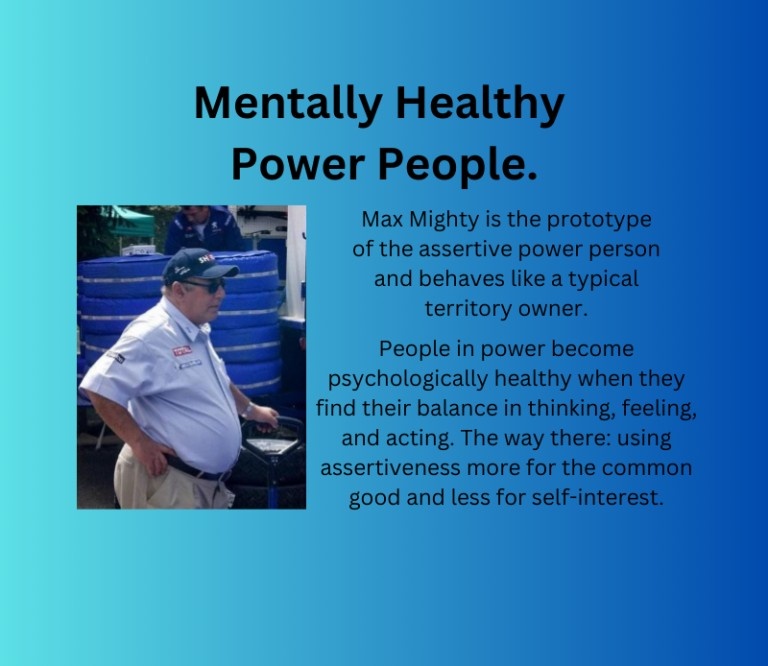
Dominant Power People behave like territorial leaders—they want to control relationships within their domain. Among them, we find dictators, patriarchs, adventurers, entrepreneurs, gruff personalities, warriors, and tough guys. Power People achieve psychological well-being when they learn to use their strength for the benefit of the community they live in. By doing so, they earn respect and recognition from those around them. They learn to develop empathy and compassion. They overcome their tendency to dominate others and instead use their power to uplift and support.
Development Opportunities in Feeling and/or Thinking
The Power Person is primarily focused on their own well-being and uses their strength and influence to advance their own interests. Independence, including in financial matters, is crucial to them. They are adventurous, bold, and open to risky ventures, even in business. They seek complete control over their surroundings—they can be domineering, overbearing, and forceful, imposing their will and opinions on others while intimidating those around them.
The recommended integration path leads toward “placing the interests of the community above personal gain.” Through this transformation, the Power Person learns to use their strength not just for themselves, but for the benefit of others. They redirect their power and influence toward serving the community they live in. This shift earns them genuine respect and admiration from those around them. They become generous, caring, and supportive, actively helping and protecting those in need. They develop empathy and compassion, overcoming their desire to control and dominate others.
A developed Power Person is decisive and self-confident. They use their strength for the well-being of the community instead of for personal gain. They apply their influence constructively, protecting and advocating for those around them. They take on roles as mentors, protectors, and supporters, contributing as leaders, sponsors, and benefactors. They earn genuine respect and admiration from their peers and learn to temper power with mercy.
The Generous Hero has overcome their need to dominate. They become a patient and magnanimous individual, exuding natural authority rather than controlling others. They dedicate themselves to serving the community, offering leadership, security, and protection.
The Strong Executor radiates inner stability and confidence. They recognize their ability to remove obstacles, using their determination and resilience to overcome any resistance or pressure. They are decisive and self-assured, taking swift and effective action.
The Constructive Leader possesses personal authority and sets high goals. They use their strength to tackle any challenge. People believe in them, look up to them, and trust them to lead with integrity and purpose.

Harmony-oriented Peacemakers adapt to the people around them and often appear complacent and passive.
Peacefulness is their defining trait. Anything related to aggression, confrontation, or conflict makes them uneasy and is often avoided or suppressed. A typical characteristic of Peacemakers is having had an idyllic and happy childhood. Peacemakers achieve psychological well-being when they become more self-confident and proactive. They learn that life involves a balance of competing interests, and that conflict is a natural and necessary part of growth. By engaging with life fully, they gain vitality and joy. They begin to take responsibility for their own decisions and actions. Through this transformation, they find inner peace and become respected and effective Peacemakers.
Development Opportunities in Thinking and/or Acting
The Peacemaker prefers to go with the flow, taking the path of least resistance and avoiding drawing attention to themselves. When given free space for self-development, there is a risk that nothing happens—this can frustrate those around them. If there is no external pressure, they do nothing. If there is too much external pressure, they simply wait it out. In some cases, they distract themselves with hyperactive activities, often without purpose or direction. They engage in trivial tasks to avoid addressing more important and necessary matters. They avoid conflict, seeking harmony and peace at all costs. To achieve this, they downplay difficulties and deny real problems rather than facing them directly. They ignore conflicts stubbornly, hoping to outlast them or distance themselves from them entirely.
The recommended integration path points toward “developing greater self-confidence.” Along this journey, the Peacemaker learns that life is a field of competing interests and that conflicts are a natural part of it. By engaging with this dynamic reality, they gain vitality and joy in life. This strengthens their self-trust, allowing them to take responsibility for their own decisions and actions. While they remain sensitive to the needs of others, they now engage from a position of openness, compassion, and calmness. They become deeply rooted within themselves, making them capable of forming meaningful, balanced relationships. People around them trust them, as their optimistic and composed presence helps others find peace and true harmony. They assert themselves without aggression, maintaining strong relationships while confidently setting boundaries. They have found their inner peace.
The developed Peacemaker has overcome their tendency toward self-sacrifice and has developed a strong sense of self-worth.
They feel autonomous, radiating contentment and inner balance. At the same time, they have retained their sensitivity to the needs of others. They are open, emotionally stable, and peaceful. They are skilled mediators and integrators, promoting harmony in their surroundings while providing support and stability for those around them.
The Centered Individual is in harmony with themselves and the world.
They have overcome the fear of being separate from others, gaining a sense of autonomy.
They experience deep inner peace and serenity.
They have finally found the peace they have always sought, because they have truly come home to themselves.
The Receptive Person has a high tolerance for stress and disruptions.
They are patient, unshakable, balanced, and calm.
They can deeply connect with others and fully dedicate themselves to the people who play a central role in their life.
As a result, they become a safe harbor, offering others comfort, security, and a sense of belonging.
The Kind-Hearted Peacemaker works tirelessly to create peace and resolve conflicts in their surroundings.
They seek out common ground and shared values between people,
always striving for reconciliation and understanding.
Why is Saying “No” So Difficult for Hans Helfer, When It Comes So Naturally to Others Like Little Maja?
It is not due to how others perceive him or how he is judged by those around him.
Instead, it lies in his self-image—how he sees himself—and in his ideal self-image,
how he wishes to be seen by others.
Clearly, obstacles, barriers, and limitations exist within him, preventing him from practicing
a behavior that should be as simple and natural as saying “no.”
The developmental stages of the personality model used here are not widely known.
There are currently few sources of information on the topic.
As a result, this lack of knowledge itself can serve as a barrier.
However, this barrier can be easily overcome by reading and understanding the explanations provided here.
This is undoubtedly a major obstacle.
In order to learn new behaviors in areas of personal deficiency,
a person must first become aware of their own deficits. According to the Johari Window model, these deficits hide in the “Blind Spot.” That means they are not directly visible to the person themselves,
but are clearly noticed by those around them. If a person is willing to look in the mirror and accept feedback from others,
they can recognize their weaknesses and begin to grow.
However, not everyone is ready to take that step.
The False Assumption of Having Reached the End of Personal Development
A personality may prematurely abandon their own developmental journey under the false belief that they have already reached the final stage of their personal growth, assuming that there is nothing left to develop.
Admitting that this assumption might be wrong is, of course, particularly difficult.
Additionally, the comfort of routine plays a role.
The individual has settled into the familiarity of their habits, creating a cozy and predictable environment.
As a result, they become reluctant to step outside of this comfort zone.
However, true growth does not happen within the confines of familiar habits.
It is personal arrogance that restricts and limits growth in this case.
Those who see themselves as superior believe they have no need for further development.
After all, they are already ahead of everyone else, aren’t they?
The realization that there are eight other equally valid life paths is ignored and suppressed.
After all, if these other paths were just as valuable, then the feeling of superiority would become meaningless.
“That simply cannot be, can it?”
Copyright © 2025 – PBI Learning Hub Designed by Click Creek